#west-frisia
Photo

Konkelbank in Monnickendam, the Netherlands
A Konkelbank, from West-Friesland, are little benches attached to the front of a house. On this, people could 'konkel' or gossip, they would keep an eye on the happenings of the neighborhood.
#west-frisia#west friesland#monnickendam#holland#gossip bench#konkelbankje#the netherlands#villagecore#cottagecore#farmcore#europe#dutch culture
102 notes
·
View notes
Video
Molen Zuider-G, village of Burgerbrug, The Netherlands. by Alex de Haas
#Aurora HDR#DJI#Dutch#Europa#Europe#Grote Sloot#HDR#Holland#M2P#Mavic#Mavic 2 Pro#Molen Zuider-G#Nederland#Nederlands#Netherlands#Noord-Holland#West Frisia#West-Friesland#Zuider-G#aerial photography#avond#canal#countryside#drone#evening#kanaal#landelijk#landscape#landschaft#landschap
10 notes
·
View notes
Text
Pagan/Occult timeline on this Tumblr
(with some accents on Frisia/Holland/the Netherlands)
Stone Age
Palaeolithic
. Rock art
Mesolithic
. Swifterbant Culture (in the NL ca. 5300-3400 BCE)
Neolithic
. Vlaardinger Cultuur (in the NL ca. 3500-2500 BCE)
. Trechterbekervolk (= Funnel Beaker Culture, in the NL ca. 3350-2750 BCE ) and their Hunebed (dolmen)
Ancestor worship may have existed in the Neolithic.
Some scholars suggest a direct link between Palaeolithic female ('venus') figurines and female depictions in the Neolithic and even Bronze Age. In the Copper Age, male deities were also worshipped, and there was a development towards forming a complete pantheon with mythological figures.
Domestication of plants and animals is in its formative stages here, and 'Industry' comes up, mainly of utensils and ornaments.
The invention of writing started here, between copper and bronze age. Invention of the wheel. Invention of the potter's wheel.
Bronze Age
Hallstatt Culture (roughly 1200-450 BCE)
Northern Bronze age (roughly 2000-500 BCE)
2000 BCE
17th century BCE
15th century BCE
13th century BCE
11th century BCE
10th century BCE
8th century BCE
. Oldest findings of Frisian pottery
7th century BCE
6th century BCE
Northern Iron age (roughly 500 BCE - 800 CE)
5th century BCE
4th century BCE
3rd century BCE
2nd century BCE
1st century BCE
1st century
. Oldest known runic inscription
2nd century
3rd century
4th century
. Big migration of North German and Danish tribes into East and Central (=North of the NL) Frisia, and expansion of West Frisia
5th century
. Oldest known runic inscription mentioning Oðinn
. Big migration of North German and Danish tribes into East and Central Frisia and expansion of West Frisia
. Rise of the Merovingian dynasty among the Franks
6th century
. Frisia is at its peak and now covers the Dutch entire North + West coastal region, river area, and North coast of Germany
. Merovingian dynasty at the Franks - expansion
7th century
. Transition younger futhark.
. Merovingian dynasty at the Franks - expansion
8th century
. Transition younger futhark
. Merovingians (Franks) incorporate Frisia. Put a lot of effort into converting forcing the local tribes in Europe to Christianity
Viking age (roughly 800-1100 CE)
9th century
. In now Frankish 'Frisia', the name Holtland appears
10th century
. Estimated writing of the Vǫluspǫ́.
11th century
12th century
. Floris II no longer calls himself Frisian, but Count of Holland
. Earliest known Western heraldic
The last bits of the Medieval age
13th century
. Estimated start of development of Christian "Kabbalah"
14th century
15th century
. Giovanni Pico della Mirandola (humanist, Hebrew studies)
. Johann Reuchlin (humanist, Hebrew studies, developer of the angel names)
. Heinrich Cornelius Agrippa (occultist, developer of the demon-scales)
Modern History
16th century
. Giordano Bruno
. Edward Kelley (also known as Edward Talbot)
. John Dee (occultist, developer of Enochian magic)
. Sir Francis Drake's drum
17th century
. Dutch Streekdracht Folklore estimated start
Athanasius Kircher (developer of the Tree of Life as used in Hermetic Kabbalah)
. Rosicrucianism
. The Lesser Key of Solomon
18th century
Dutch Streekdracht Folklore peaks
19th century
Dutch Streekdracht Folklore peaks
. Éliphas Lévi, real name Alphonse Louis Constant (occultist, writer of Dogme et Rituel de la Haute Magie and initiator of the Kabbalistic Cross)
. Helena Blavatsky (occultist, founder of the Theosophical Society and famous for her Atlantis work)
. Samuel MacGregor Mathers & William Westcott (founders of the Hermetic Order of the Golden Dawn)
. Arthur Edward Waite (occultist, GD member, laid down the foundations for nearly all contemporary tarot decks)
20th/21st century
Dutch Streekdracht Folklore decline
. Dion Fortune (occultist)
. Israel Regardie (occultist)
. Gerald Gardner (founder of Gardnerian Wicca)
. Doreen Valiente (co-founder of Gardnerian Wicca)
. Gareth Knight (occultist)
. Walter Ernest Butler (occultist)
. Dolores Ashcroft-Nowicki (occultist)
. Alex Sanders (founder of Alexandrian Wicca)
. Diana L. Paxson (Witch, Wicca, Asatru)
. Marian Green (Solitary Witch)
. Vivianne Crowley (Wicca)
. Frigga Asraaf (NL Asatru)
. Linda Wormhoudt (NL Shaman)
3 notes
·
View notes
Text
i’m playing ck3. anglo-saxon pagan. my immediate goal is forming the north sea empire.
anyway, i just noticed one of my norse vassals isn’t asatru. they’re not even christian.
they’re bori. i don’t even know what that is. i had to look it up. apparently it’s some west african animism. and i was curious why this minor nobleman in scandinavia was practicing a west african faith. and i realized both of his parents were also “bori” and his grandparents and then his great grandparents.
that’s when i realized....bori is spread throughout eastern europe and siberia. apparently some ruler of the khazar khaganate like over a century ago had converted to bori (i don’t know how or why -- i see no west african people in their dynasties) and it’s just been slowly spreading ever since. the khaganate eventually collapsed and all of its many successor kingdoms are also lead by khazars who practice bori.
and i also noticed even further east the rest of siberia is almost entirely islamic. tengrism is nearly extinct except for a couple of holdouts.
and the funny thing is the territories where bori comes from (west africa) is now almost entirely catholic. bori itself is nearly extinct in west africa.
and i’m slowly but surely converting europe to germanic paganism. i’ve already got the british isles, scandinavia, northern germany, frisia, and i just conquered provence, genoa, corsica, and rome. so they should be asatru soon enough. and when i finally dismantle the papacy the rest of europe should follow.
which means west africa will become the last stronghold of catholicism. and eastern europe/siberia will become the last stronghold of bori.
5 notes
·
View notes
Text
Willemy
Willemy is a polity in northern Europe, situated east of Norman Kent and France.
History
The Duchy of Willemy was a minor polity within the German Empire during the Second Tetrarchy of the eleventh and twelfth centuries. Forming much of the empire's border with the First Drengot Empire to the west, defence against the marksmen of Willemy led Drengot Emperor Roger II to spend greatly on castle fortifications from Flanders to the Alps.
The Great Flie Flood of 1171 swept away much of Lower Frisia in Willemy, creating several new islands in the Rustigh Strait (such as Texel) and killing then-ruler Lovis the Tall, who was in Amstel at the time. The devastation in the region is thought to have allowed Borlish Axbane to flourish as a trading post in the following century.
In the Revitalist Period and for some time afterwards, Willemy was split between neighbouring powers and portions of its territory changed hands regularly. The duchy of Avosche was unusually stable and held by France for over a century.
Trading operations from Willem and its cities in the Stadbund (the Bróderrat) contributed to staddomains in Atlantic Cappatia, most notably Neuwillem, whose Bróderratcronike (comprising a record of its activities from 1561 to 1597) is an important first-hand account of conditions in the region at the time.
Willem was the focal point of the seventeenth-century Blue Trans-Willem War, usually numbered among the Romantic Wars. This war led incidentally to the dissolution of the Kingdom of Burgundy and the creation of the Duchy of Far Suebia in Bavaria.
The two-arm system for sending steeplepost was first deployed in Willem in the early nineteenth century, to send the first lines of the Pater Noster from the church in the town of Thynen to neighbouring Bost. This event is likely what led to the name 'steeplepost' being applied to the technology.
People
Rulers
Duke Lovis the Tall (d. 1171), who perished in the Great Flie Flood
Adaillé Nassow, Duchess d'Avosche (1524-1608), infamous during her life for her influence at the court of David of France
Other
Carlyn van Stede (fl. 1965), author of parachthon giftale 'While Gold Yet Runs in My Veins' (Zolang Gout dór myn Ádren Noh Vlóye)
Dr Mickel Cráyenschot (fl. c19), noted early supporter of the Deviance movement and public tovarick even as France embraced the Modest Arrangement.
Niklás der Fecht (fl. 1828), a mathematician in the city of Axton
Tewis Camigner (fl. c16), theorist who noted the high sugar content of beet syrup, though betraver sugar would not be produced commercially for another two centuries
3 notes
·
View notes
Text
Cccp, Fedeli alla linea 1984 – 2024 a Reggio Emilia
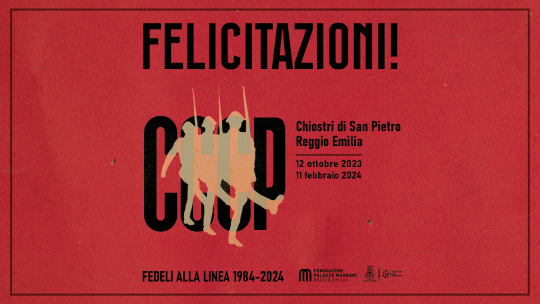
"I Cccp non potevano che nascere a Reggio Emilia, la città più filosovietica del blocco occidentale", ha detto Giovanni Lindo Ferretti, voce della band che, circa quarant'anni fa, con il primo EP Ortodossia, cominciò a cambiare la storia della scena punk italiana.
Sciolti nel 1990, poco dopo la caduta del muro di Berlino, da allora i Cccp sono sempre stati presenti nel panorama musicale italiano, dove le loro canzoni sono state reinterpretate, sono usciti documentari, libri, perfino tesi universitarie sulla loro musica.
La mostra ai Chiostri di San Pietro di Reggio Emilia sulla storia del Cccp , aperta fino all’11 febbraio 2024, stata ideata da Ferretti, insieme a Massimo Zamboni, Annarella Giudici, Danilo Fatur, che hanno dato vita a un'enorme esposizione-spettacolo che invade 28 stanze per un totale di 1800 metri quadri.
Annarella Giudici ha messo a disposizione le memorie, gli oggetti, i costumi di scena che ha conservato nel tempo, così le loro performance rivivono sugli schermi, gli slogan, i testi delle canzoni invadono gli spazi, come i titoli della carta stampata a loro dedicati,
Sono tanti i luoghi che si incontrano nel percorso espositivo, Berlino, la città dove tutto ebbe inizio, nel 1981, e poi Reggio, Carpi, Beirut, il mondo arabo, Urss e paesi satelliti, Cina, Mongolia, Kabul, fino a Fellagara, la casa dei primi Cccp, quella che ha potuto ascoltare in anteprima assoluta le loro prime canzoni.
All'ingresso, superata l'enorme scritta Felicitazioni, nel chiostro piccolo si trova una parata di 24 bandiere degli stati socialisti che non esistono più, nel chiostro grande una lastra originale del Muro di Berlino, dal quartiere Treptow, e una Trabant, circondati da cavalli di Frisia, mentre un cartello avverte Sie verlassen jetzt West Berlin" cioè State lasciando Berlino Ovest.
Il viaggio continua nelle sette sale del piano terra, con un omaggio a Luigi Ghirri, incaricato di rappresentare il disco finale Epica etica etnicae pathos e vi sono esposte tutte le 28 fotografie, in parte inedite, che Ghirri scattò a Villa Pirondini.
Al primo piano ci sono la Stanza della Grafica, l'incontro con la Storia, la stanza Amandoti, dove un'enorme installazione sonora riproduce l'unico inedito dei Cccp, , disponibile solo qui.
La mostra è stata promossa dal Comune di Reggio Emilia, Fondazione Palazzo Magnani, mentre il progetto è stato finanziato grazie ai Fondi Europei della Regione Emilia-Romagna.
Read the full article
0 notes
Text
On this day in Wikipedia: Sunday, 30th July
Welcome, Willkommen, Bienvenida, שלום 🤗
What does @Wikipedia say about 30th July through the years 🏛️📜🗓️?

30th July 2022 🗓️ : Death - Nichelle Nichols
Nichelle Nichols, American actress, singer and dancer (b. 1932)
"Nichelle Nichols (, born Grace Dell Nichols; December 28, 1932 – July 30, 2022) was an American actress, singer and dancer whose portrayal of Uhura in Star Trek and its film sequels was groundbreaking for African American actresses on American television. From 1977 to 2015, she volunteered her time..."

Image licensed under CC BY 2.0? by Alan Light
30th July 2018 🗓️ : Death - Michael A. Sheehan
Michael A. Sheehan, American author, former government official and military officer (b. 1955)
"Michael A. Sheehan (February 10, 1955 – July 30, 2018) was an American author and former government official and military officer. He was a Distinguished Chair at the U.S. Military Academy in West Point, New York and a terrorist analyst for NBC News...."

Image
30th July 2013 🗓️ : Death - Ossie Schectman
Ossie Schectman, American basketball player (b. 1919)
"Oscar Benjamin "Ossie" Schectman (March 30, 1919 – July 30, 2013) was an American professional basketball player. He is credited with having scored the first basket in the Basketball Association of America (BAA), which would later become the National Basketball Association (NBA)...."
30th July 1973 🗓️ : Birth - Clementa C. Pinckney
Clementa C. Pinckney, American minister and politician (d. 2015)
"Clementa Carlos "Clem" Pinckney (July 30, 1973 – June 17, 2015) was an American politician and pastor who served as a Democratic member of the South Carolina Senate, representing the 45th District from 2000 until his death in 2015. He was previously a member of the South Carolina House of..."
30th July 1922 🗓️ : Birth - Henry W. Bloch
Henry W. Bloch, American banker and businessman, co-founded H&R Block (d. 2019)
"Henry Wollman Bloch (July 30, 1922 – April 23, 2019) was an American businessman and philanthropist who was the co-founder and (since 2000) the chairman emeritus of the American tax-preparation company H&R Block. He and his brother, Richard Bloch, founded H&R Block in 1955 in Kansas City, Missouri...."
30th July 1818 🗓️ : Birth - Emily Brontë
Emily Brontë, English novelist and poet (d. 1848)
"Emily Jane Brontë (, commonly ; 30 July 1818 – 19 December 1848) was an English novelist and poet who is best known for her only novel, Wuthering Heights, now considered a classic of English literature. She also published a book of poetry with her sisters Charlotte and Anne titled Poems by Currer,..."
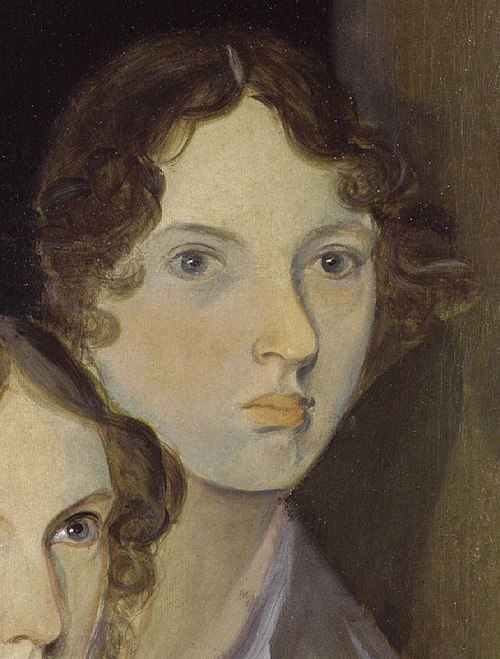
Image by
Patrick Branwell Brontë (died 1848)
30th July 🗓️ : Holiday - Christian feast day: Hatebrand
"Hatebrand was a Benedictine abbot. A native of Frisia, Netherlands, he became the Abbot of Olden-Klooster, Frisia in 1183. He is famed for having revived the Benedictine order, in the area of Frisia. ..."
0 notes
Photo

Portrait of Philip IV, King of Spain, from 'Counts and Countesses of Holland, Zeeland, and West-Frisia'. 1650. Credit line: The Elisha Whittelsey Collection, The Elisha Whittelsey Fund, 1951 https://www.metmuseum.org/art/collection/search/371348
#aesthetic#art#abstract art#art museum#art history#The Metropolitan Museum of Art#museum#museum photography#museum aesthetic#dark academia
0 notes
Text
Meditative Week of Poetry: Ethan Luk

You turn towards the bedside lamp.
Face crepuscular. Bust mysterious
As a sonata movement unfinished:
The pianist relinquishes his hands
Before the last cadence.
We are in a frame. Yes,
The window of the apartment.
It is night, but someone can still see us
With the precision of a Vermeer painting:
We are in the second-floor of his studio
Where the window opens
To Delft, and the light languishes
Like a sigh only exchanged
By two strangers who don’t know
Each other. Vermeer was known
For the genre painting. Aren’t we
A genre? Playing the part
Of the twink. Following each other’s lead
In the play of foreplay. Vermeer uses lapis lazuli
In the most unexpected places:
A tint in the veil of a laughing girl. A corner
In the map of West Frisia. What glimmers
In you is not as rare as the delicate blue
Mined from Afghanistan, associated
With the Virgin. But the nail polish
Bought from CVS. A lurid concoction
Of colors you only find in the vomit
I clean up on your T-shirt, or the intersection
Of strobe lights in the clubs you frequent.
In another of his paintings, a mistress drops
Her pen as a maid hands over a letter.
Behind the two is a dark background:
Through infrared reflectography, experts
Learned that Vermeer painted a phantom black
Over four, disposable figures. Of course,
There are ghosts in this room
Where you and I sit. You may think of other men.
I can, too. We are never just here.
Night is never just a meeting time,
But a secret in its deepest inflorescence.
Just as a painting is never entirely
What it presents: the blue tablecloth wilting
Under the mistress’ forearm used to be green.
Pigments change. Craquelure tumors.
But the themes remain the same in Vermeer.
Even if some characters appear only to disappear.
It’s always the same studio. His wife,
Catharina. Their children busy playing
And dying on the first floor. With our
Eyes closed, we can see all the people
Who have come before us
And cast themselves in the same role.
And I wonder when we will be tired
Divas. You don’t have a pearl earring
Harvested in the Gulf of Mannar.
It’s just a sterling silver hoop. But oh,
How the light anoints you as its subject.
The cheap luxuries we ornament
Ourselves with. The cheap luxury of you
Just turning your face. The letter
In its deepest inflorescence: opening up
To confession and privacy all at once
In the unholdable hand. We play our parts
So well, we forget that we will forget
Each other by day.
0 notes
Text
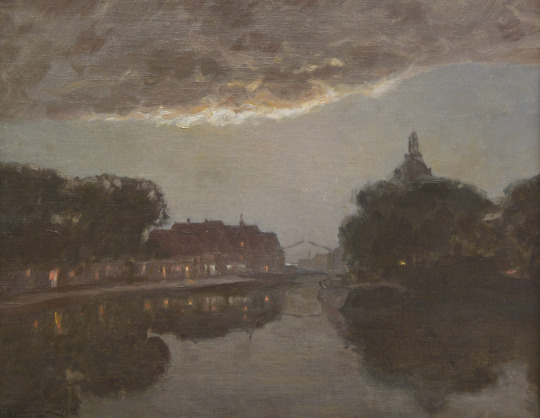
Moonlit near Enkhuizen - Friedrich Kall morgen. 1909
German , 1856 - 1924
Oil on cardboard, 42 x 53 cm.
60 notes
·
View notes
Photo

From Field To Burial Mound And To Terp
During the archeological research of the West-Frisia road in West-Frisia, the Netherlands, archeologists investigated a terp. A terp is a man made small hill on which people built their homes to protect them against the sea. Terps were mainly built by the Frisii, Frisians and the Chauci people, some of these terps are still visible and in use until this day.
This particular terp in Binnenwijzend, West-Frisia however held a secret. Apparently this terp was constructed right on top of an old burial mound from the middle bronze-age, 3200 years ago. It is understandable that people in the early medieval ages chose the best possible spot for their homes and an already existing small hill was of course perfect.
Little did they know that they built their home 50 centimeters above the graves of middle-bronze age people. This mound was used not just for one person but several people. Archeologists have only uncovered a small part of the burial mound which already contained 4 bodies. The whole burial mound itself must have contained much more bodies.
One of the bodies found was that of a male between 50-60 years old, he was 1,75 meters tall and had well developed muscles in his lower legs. His grave is quite interesting because the hole dug for his body was long and vertical but when they placed his body inside, they suddenly decided to adjust his position from a vertical one to a crouched position. This new body position did not fit in the hole so they adjusted the hole quickly before burial.
It's strange because people weren't usually buried in a crouched position. Why did the middle-bronze age people adjusted the position of his body at the last moment? We will never know. DNA research shows that the male was born, lived and died in West-Frisia.
Another body inside this mound seems to have been hastily buried as well. The body of a female between 36-45 years old was buried on her back with her arms crossed on top of her chest. But it seems that the hole they dug, wasn't big enough for her body. Her legs are slightly bent against the edge of the hole. This female was not from West-Frisia but probably came from Scandinavia.
A third body was also that of a female between 30-60 years old. She was born and raised in West-Frisia but she had scoliose in her lower back probably caused by heavy labour. Her teeth were also in a bad condition, 9 of which were gone and one was infected. She must have had a lot of pain during the last few years of her life.
The fourth body is that of a child between 5-10 years old. Research of the remains show that the child had iron deficiency due to the unilateral nutrition that the farmers consumed.
When archeologists reached the bottom of the burial mound, they discovered that the burial mound itself was placed over an even older field used for agriculture. Signs of agricultural tools like a plough are still visible below the burial mound.
The burial mound itself was in use for hundreds of years. The people inside the mound probably didn't even know each other. It's clear that these bronze age West-Frisians cared for their dead and that they lived a hard life which took a toll on their bodies. Not only the woman had scoliose, the other two adults show signs of a worn out back as well.
It's fascinating how this piece of land was first used to grow crops, then they built a burial mound on top of it. Once the burial mound was forgotten, people of the early medieval ages decided to use the mound as a terp to protect their homes against the water, not realising that it was used to bury several people. Centuries later the terp was be discovered again because modern West-Frisians want to construct a road on top of it.
Photo of:
Archeologists uncover a body inside this burial mound,
20 notes
·
View notes
Photo

#westfriese omringdijk#eenigenbrug#holland#the netherlands#west friesland#west frisia#farmcore#fields#natureblr#route
597 notes
·
View notes
Video
De Molen van Piet, Clarissenbuurt, city of Alkmaar, The Netherlands. by Alex de Haas
Via Flickr:
Support my work, become a Patreon patreon.com/alexdehaas
#11mm#Alkmaar#D850#De Molen van Piet#Dutch#Europa#Europe#HDR#Holland#Irix#Irix 11mm#Luminar Neo#Nederland#Nederlands#Netherlands#Nikon#Nikon D850#Noord-Holland#West Frisia#West-Friesland#Westfries#binnenstad#center#centrum#city#city center#cityscape#inner city#mill#molen
2 notes
·
View notes
Text
Tags related to a pagan North-West on this Tumblr A-F
Altar
Amber
Amulet
Ancient Egypt
Ancient Sumer
Angel
Arrow
Athame
Axe
Baðuhenna
Bead
Berserkr
Bind rune
Blood
Blót (Sacrifice)
Boline
Bone
Bottle
Bovine worship
Bow
Box
Brísingamen
Bronze
Burial mound
Candle
Cauldron
Ceremony
Chalice
Chartres-labyrinth
Circle
Cloak
Cloisonné
Constellation
Cosmic ocean
Crescent moon
Crone
Crown
Distaff
Dolmen
Dragon
Drum
Dutch
Dutch folklore
Dwarf
Eye
Faience
Feather
Fehu
Fence
Fire
Flame
Franks
Freyja (Brísingamen, falcon, necklace)
Freyr
Frigg (Distaff, Eski, falcon, Fulla, Gná, Hlín, Hófvarpnir, necklace)
Frisia
Frisian futhorc
Full moon
Fur
Futhorc
0 notes
Text

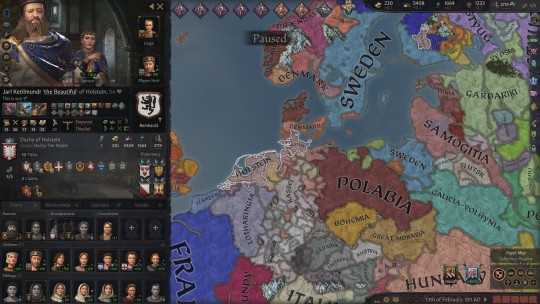
ck3 christopagan hre sitrep (long post. a lot has happened.)
so current on my third generation (this is my first character's grandson.)
stuff that's happened: my liege (the king of east francia) managed to conquer both bavaria and lotharingia. he was probably /this/ close to meeting the conditions to restore the holy roman empire. but alas, for whatever he did not. and he ended up dying and his three kingdoms were distributed between his three sons. the bavarian kingdom title was destroyed so now someone needs to reconquer it and recreate it.
but anyway, as you can see, in the brief window where the three kingdoms were united i managed to pretty much conquer all of frisia and holland.
but then something interesting happened. my new liege (the son of the first king of east francia) really hated me for some reason. he was my rival. and eventually he revoked the holland duchy from me. then frisia. and finally he was trying to revoke holstein from me. obviously if i agreed this would have been game over so i had to refuse.
and surprisingly, like half of the kingdom rose up against the "tyranny" of our king. and with the help of my fellow-vassals we were able to depose the corrupt king and his son inherited the kingdom.
now, i spent the last decade or so slowly pressing my claims on my old duchies (frisia and holland) and i'm solidifying my hold.
so now i'm at a crossroads. i don't like my new king for a variety of reasons. so i have a few options i'm considering.
i pretty much have control of what i want to be the "core" of my future holy roman empire. basically, it's the hanseatic league but a few centuries earlier. but right now it's three independent duchies (and i'm very close to getting a fourth). right now i have them all as "elective" and i think i can manage to keep them unified indefinitely. but i'd really like the security of having them unified as a "kingdom" (roleplaying it as a "league" or "republic").
or i can just gun it for the kingdom of east francia directly. i can scheme or conquer my way to a claim.
decisions, decisions.
other notes: west francia broke in half into the kingdoms of france and aquitaine. they were separate for a few decades but were recently reunified as france.
meanwhile, burgundy and italy have also been going at it. they keep alternating control. sometimes the kingdom of burgundy conquers or inherits italy and sometimes italy conquers or inherits burgundy. right now they seem to be at a stalemate. but the two kings are brothers who are each other's heir. so whichever one dies first will inherit the other kingdom.
oh also for a brief moment almost all of scandinavia was united under a single king (the king of denmark). and of course when that king died everything went to shit. somehow the king of polabia is a jute who has interests in scandinavia (he inherited jylland and conquered part of norway). also sweden has a good chunk of pomerania and southwest finland. meanwhile sapmi is a powerhouse. apparently it (sapmi) is also ruled by a distant cousin of my character's. looks like one of those early marriages eventually paid off.
also, don't get me started on great britain. that shit is a fucked up mess.
0 notes
Text
Nieuwe stoere outfit voor damesteams West Frisia en Dindua
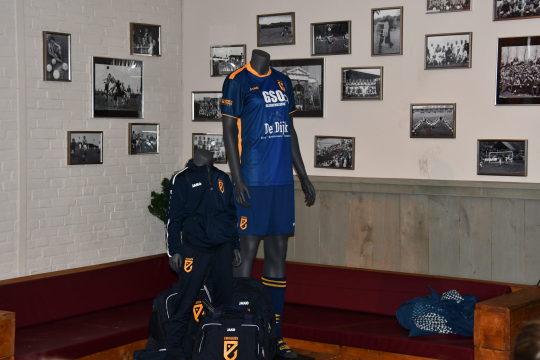
ENKHUIZEN - Na lang wachten was het vanmiddag dan eindelijk zover. De nieuwe samenwerkings tenues voor de gezamenlijke damesteams West Frisia/Dindua werden vanmiddag op het Immerhorn sportpark in bijzijn van wethouder Dorus Luycks dan eindelijk onthult.
Mooie frisse tenues voor de dames elftallen die al drie seizoenen gezamenlijk de andere damesteams in de regio te lijf gaan. Stoere kleuren die aansluiten bij de locatie langs het IJsselmeer, het blauw van het water van het IJsselmeer met een mooi oranje achtig logo waarin van alles te zien is. De keepers gaan in het rood, een mooie opvallende kleur waardoor er 5% meer kans is dat de tegenpartij de bal richting de keeper schiet i.p.v. van net langs de keeper heen het doel in.
Dat beide clubs erg blij zijn met de nieuwe outfit mag duidelijk zijn, vooraf werd dan ook een toast gehouden in de bomvolle kantine van West Frisia waar alle speelsters, coaches en trainers aanwezig waren bij de onthulling en waar direct na de onthulling de trainers en coaches voorzien werden van bijpassende trainers jas om zo trots de kleuren van de clubs uit te dragen naar de buitenwereld toe.
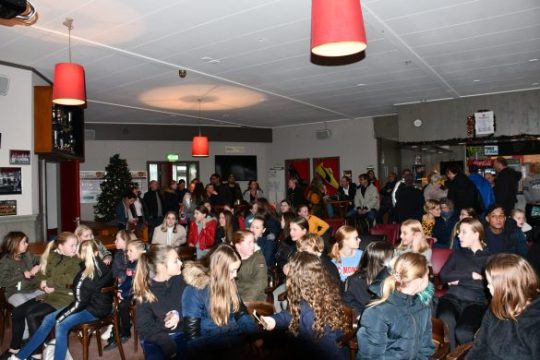



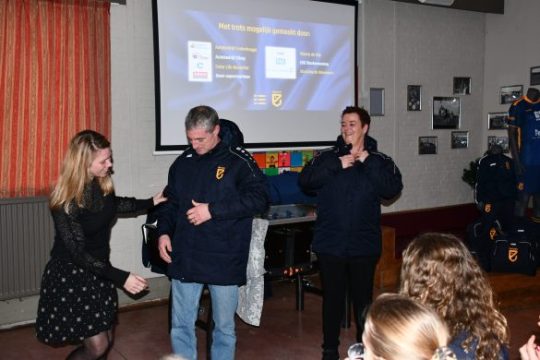


Read the full article
0 notes